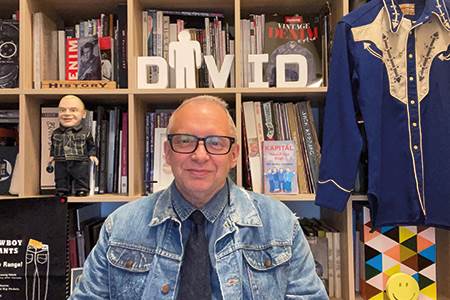From global to local

The Magic of Denim Consultancy founder David Tring shares his personal news and views, from the making of his future denim archive to the evolution of globalisation and work and how they will shape the future of the industry as seen from Hong Kong.
David Tring, founder of The Magic of Denim Consultancy, visiting fellow at the Hong Kong Design Institute (HKDI), self-described denimhead and keen skateboarder of half a century, unpicks the warp and weft of his life in denim, from starting out on the shop floor in England as a teen to taking Lee to the top in China.
Q Tell us the story of your denim library. How does it reflect, and how has it informed, your journey in denim so far?
A I have been collecting denim books and Japanese denim magazines for around 30 years. At the beginning, it was the Japanese magazines like The Jeans by World Mook, Boon Extra or Lightning Archives that really excited me. They went into such detail and still do. There would be close-up photos of the seams, buttons and all the historical details – I have always loved details, so these magazines were hard to resist. One summer in Hong Kong, I had a Japanese student translate some of them for me. [It turns out that] not all their historical information is correct, but I think that’s normal with history as we are always finding out new information from newly discovered documents.
My favourite denim book from recent years is The Denim Manual, published by a Hong Kong company called Fashionary. It is beautifully put together and covers denim’s history and manufacturing methods in a clear and simple format. It’s a perfect manual for people entering the industry. Its old-school illustrations remind me of the vintage mail order catalogues from the 1920s, when they did not have access to product photography.
You’ve previously described worn denims as almost a map of how we have lived. How does this kind of knowingness feed into your design and consultancy work?
One of the amazing things about denim is its durability, repairability and how it looks better and better the longer you have it. I have several pairs of jeans that are around 20 years old that I can still wear. It amazes me that their whisker patterns and wear lines are almost identical, like a fingerprint of my wear habits. I use these jeans in my lectures and masterclasses to show just how durable and amazing denim really is. There is no other fabric like it and that longevity also helps with living a more sustainable lifestyle. Buy a good quality pair of jeans and they can last you a lifetime, only needing a little bit of TLC along the way.
What, for you, would be the qualities, properties and values woven into denim worthy of inclusion in an archive assembled around the year 2050?
There is a British satirical science fiction film from 1951 called The Man in the White Suit, starring Alec Guinness. It tells the story of a scientist who was obsessed with inventing a fibre that was everlasting, self-cleaning and never wore out. I won’t ruin the ending for everyone, but we definitely need this type of innovation in the future archive.
The United Nations (UN) has set targets for our world to achieve net-zero emissions by 2050. For me, any denim product featured in the archive of 2050 would have to have taken us on that journey towards carbon neutrality. We are only at the beginning of that journey and there’s still a very long way to go. There is a tremendous amount of innovation in chemicals, indigo dyeing and garment finishing and that gives us a good base to start from, but we still need more innovation, especially in our base fabric. It’s really exciting to see new options coming through like Renewcell’s Circulose dissolving pulp from 100% textile waste.
Could you explain the key differentiators that spurred Lee towards taking the top spot in China, having helped lead the brand’s Asia-Pacific arm between 1998 and 2022?
Lee was one of the first international clothing brands to enter China in the 1990s. The Chinese market was not very developed at that time, so it was mainly a jeans wholesaling strategy with retail partners. I moved from the European business [then part of VF Jeanswear] to Hong Kong in 2006, initially focusing on Wrangler and Lee’s Asia-Pacific brand licensing partners, which was a real learning opportunity for me.
By 2008, Lee China has started to plateau. A new team was put in place to run the business, with me leading the product design, merchandising and buying teams. The Chinese market was changing, and we needed to change with it. Retail formats were becoming more sophisticated and customer expectations were rising, as were retail prices. Many of our competitors took a more centralised view and offered product ranges aligned with their global strategy. At the time, Lee was a poor number three in the market, behind a local brand called Apple Jeans and the runaway market leader, Levi’s. One of the great things about being at VF around that time was the company’s investment in consumer research. We undertook a number of different projects, including ethnographic research which involved consumer “shopalongs” and even wardrobe walk-throughs. I loved going into homes and talking to Chinese consumers about their favourite jeans and tops, and what they did and did not like, from fashion to music and culture. The learnings from those interactions could never be fully repeated in a report, too much gets lost in translation.
Coming out of that research, we decided to pursue a hyper-localisation strategy, putting the Chinese consumer at the centre of our decision-making. We also invested in our retail stores and people. We started designing and delivering biweekly drops of floor-ready coordinated programmes designed specifically for Chinese consumers, with strong themes and storytelling and a big tops offer. Chinese consumers are excited by innovation and what I like to call “visual value” details, such as washes and prints that can clearly be seen and help them to express themselves. Lee became the number one jeans brand in China by 2014, and it still is today, delivering some of the highest margins globally for VF Jeanswear [now Kontoor Brands]. If you really understand your customer, then it does not have to be a race to the bottom.
One key learning I took away from this was that copying the strategies of the market number one, or your biggest competitor, will not always work. Brands need their own positioning and strategies that are right for them. Too often brands fall into the trap of copying the market leader – you have to differentiate. When I talk to buying and merchandising teams for international brands, the main complaint and obstacle they see to growing their Chinese or Asian business is that they cannot find the “right” product from their global line. Covid-19 may have put the last nails in the coffin of globalisation, but I feel that it’s been on its last legs for a really long time. Consumers are local, not global; they have localised influences, trends, opinion leaders and tastes. Many so-called global influencers remain unknown in China.
You got your start in the denim business working weekends at an English clothing store as a teenager in the ‘70s. What excites you about contemporary fashion retailing?
Even pre-covid, it was clear that current models were not working. Department stores, especially, were carrying far too much inventory and fast fashion has become really, really boring. It feels like everyone is still dealing with the major issues of the last few years regarding inventory, supply chain problems and inflation. In Hong Kong, we went from being the most visited city in the world to practically zero visitors overnight due to the pandemic-related lockdowns, but thankfully we are now open for business again.
Despite this, one thing that’s really excited me is the emergence of local creatives opening their own retail stores and pop-ups. There’s an area of Kowloon in Hong Kong called Sham Shui Po. It is the oldest textile district here and is now seeing a lot of these new stores and coffee shops. Later this year, the area will host a denim festival, which I am really looking forward to.
The mainland Chinese market will also be interesting to monitor, now that it is opening up again. Shopping mall landlords in China expect their tenants to come up with a new retail format for all major malls and to update this format every two to three years, which is very different from the West, for instance. It forces brands and retailers to keep coming up with something fresh and different.
If that same teenager were just starting out today, with the very same passion for denim and skateboarding, where do you think he would go and what do you think he would do to realise his heart’s desires?
The main difference today is access to information at speed, thanks to the internet. I talk a lot with my students about the need for curiosity. There is so much information – just look at all the streetstyle bloggers on Instagram. At the same time, though, it is just as important to take a camera out with you and take your own photos and build your own experiences. Looking through the lens is a different learning experience from looking at somebody else’s images on a screen.
My skateboarding would have been a lot better [with today’s easy access to information]. Back in the day, we had to learn tricks from still photos in magazines and just imagine how they were achieved, then experiment. Nowadays, I see skaters watching YouTube and filming themselves as they do tricks, which is great because they can study the speed, angle and technique needed. Information gives you power.
If you combine curiosity with passion for what you do and a willingness to learn, I truly believe anything is possible. I hope I would have ended up in the same place as I have, as I love the journey I have been on. Even the choices and experiences that didn’t work out still enabled me to learn.
What should the industry be doing to help develop great people, not just great products?
The only way to create great products is to nurture and inspire great people. All industries are going through one of the biggest changes in recruitment and retention that we have ever experienced. This has mainly been driven by covid, but the new generation are also not as willing to tolerate some of the old situations in companies. There’s a major culture gap now between the older and the newer generations. I don’t think the gap has been this big since the baby boomers at the end of the 1950s and I actually think that’s a good thing. We need change. Young people are far more willing to make career choices based on their values and the older organisations will have to change or risk being replaced. I really like the attitude of the new generation. They have a fresh approach, and they are not taking prisoners along the way.
How do you bring moments of magic into the everyday?
Most of my time is spent with young people in education. It is a different experience for me, compared to working for a brand, and I am still learning how to motivate and inspire them. During my final session of 2022 with six fashion denim design students from HKDI, where I am a visiting fellow, I took them to visit Jeanologia’s local hub. They all saw an amazing demonstration of the latest denim washing and finishing innovations from the team there. The laser demo, in particular, really blew them all away. After that, we went to visit the Centre for Heritage, Arts and Textiles (CHAT) and had a private tour of Japanese craft collective Buaisou’s exhibition on natural indigo dyes. The students got to see the artisans of the future in the morning, followed by heritage craft techniques in the afternoon. They loved it and it was the best day of the year for me, as I could see that denim was starting to get into their blood.
I don’t think you can experience that level of magic every day, as it takes a tremendous amount of preparation, but when it works it truly is magical. We will all need a bit of denim magic in 2023!
PHOTO: David Tring













